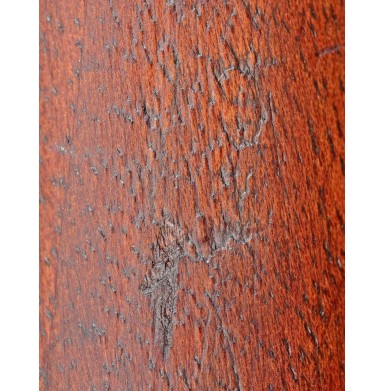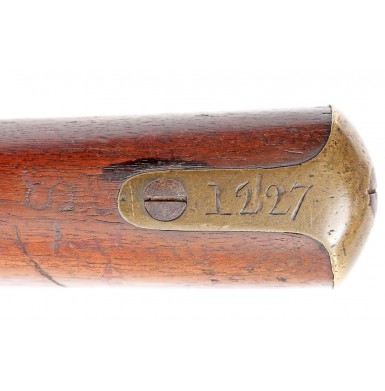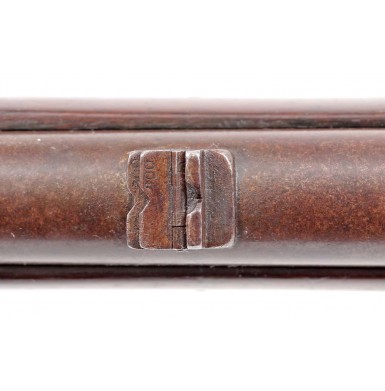Confederate Purchased & Numbered Enfield Artillery Carbine
- Product Code: FLA-2805-SOLD
- Availability: Out Of Stock
-
$1.00
The Pattern 1853 family of British military percussion long arms that started with the “Enfield” Rifle Musket gave rise to a variety of shorter, specialty troops long arms, including the 21” barreled Pattern 1856 Cavalry Carbine with a captive rammer and the 24” barreled Artillery Carbine, in three variations “ the Pattern 1853, Pattern 1853 Type II (aka P-1858) & Pattern 1861. The Artillery carbines were intended for troops that might have the need for a long arm (rather than a pistol), but did not need to be encumbered with the weight and length of either the P-1853 rifle musket (“long Enfield”) or P-1856, P-1858 or P-1860 short rifles. The Enfield Artillery carbine was the M-1 carbine of the mid-19th century British military. As these guns were only intended for use by specialty troops in the British Army, they were produced in very small numbers and are not commonly encountered today. During the American Civil War, these guns were imported by both sides, but in very extremely small numbers when compared to the number of rifle-muskets and rifles that were purchased. This makes Civil War used examples extremely scarce and very difficult to obtain. The Pattern 1853 Artillery Carbine was adopted by the British military in January 1853, with the initial contracts being let for it in October of that year. Like the rifle musket that it was patterned on, it was a .577 caliber, muzzle loading, percussion ignition long arm. The gun was brass mounted and was 40” in overall length. The 24” barrel was rifled with three grooves, making one turn in 78”, and had a bayonet lug mounted on the right side near the muzzle. The bayonet was a semi-Yataghan saber bayonet, of the same basic design as that used on the P-1856/58/60/61 pattern rifles. The bayonet for the Artillery carbine was the only one in British service (at that time) to utilize a metal scabbard, instead of the more commonly encountered leather one. The carbine had a simple three-leaf rear sight, which was graduated to 100, 200 and 300 yards. A sling swivel was mounted on the upper of the two-barrel bands and one was screwed into the toe of the stock, to the rear of the triggerguard tang. The first pattern carbines also utilized a semi-tulip head ramrod, similar to that found on Type I and early Type II P-1853 Rifle Muskets. The primary pattern changes to the carbine occurred in 1858 and 1861. The new P-1853 Type II Artillery Carbine (or P-1858) adopted the progressive depth rifling system that had been used successfully on the P-1853 Rifle Musket. At this time the ramrod was officially changed to the jag head pattern that had been adopted for the P-1853 Rifle Musket as well. There were some other minor structural changes, including the removal of the short guide tab on the bayonet lug, a design change in the rammer retention spoon, as well as the brass nose cap, all of which made the gun more like the then current production Type III Rifle Musket. The final major innovations took the form of the P-1861 Artillery Carbine. This gun adopted the 5-groove rifling system, which had become standard on all short rifles in 1860 and also adopted a new rear sight, graduate to 600 yards. The rear sight was now visually very similar to the rifle & rifle musket rear sight, with a long base and ladder with an elevating bar. The use of the rounded Baddeley Patent barrel band was also adopted for the lower band of the P-1861 carbine. There is no indication that any of the P-1861 Artillery carbines were imported by either side during the American Civil War. All extant Civil War used examples are of the P-1853 Type I or Type II, with some guns having features of both carbines, usually the Type II ramrod with earlier bayonet lug and rifling.
As previously noted, extant Civil War used Enfield artillery carbines are quite scarce, due to their limited purchase and importation by the combatants. US Ordnance documents indicate that somewhere between 480 and 730 were imported by the US for use, but it is difficult to determine for sure, as the language in the Ordnance descriptions is somewhat vague. Southern importation was significantly greater, but to date only about 4,500 of the artillery carbines can be documented as having been purchased by Confederate buyers. These Confederate purchases have been established as a contract for 1,500 of the P-1853 Artillery carbines, which were delivered in late 1861 and early 1862, as well as additional contracts from several sources that bring the total purchases to around 4,500. The early contract for 1,500 guns was inspected and marked in the same manner as the 2nd Sinclair, Hamilton & Company contract P-1853 Enfield rifle muskets, and the associated short rifle contract. Those guns were marked with John Southgate’s JS / (ANCHOR) viewers’ mark behind the triggerguard, and with an engraved inventory number on the brass buttplate tang and the ramrod shank. It appears that the majority of the P-1853 Artillery carbines were delivered by one of Sinclair, Hamilton & Company’s favorite gunmakers and retailers, W&C Scott & Son of Birmingham. All extant examples of Confederate marked P-1853 Artillery Carbines that are known to exist above #409 are marked with Scott’s furnishers mark, a large S on the stock comb, forward of the buttplate tang. This suggests that Scott delivered approximately 1,100 of the 1,500 guns (#400-#1,500). The seven known examples under #409 consist of 3 Birmingham produced carbines of various makers and 4 London Armoury produced carbines. To date, based upon a survey and inventory of extant examples, taken over more than 20 years, a total of 30 of the Confederate numbered artillery carbines are known to exist. Birmingham contractors appear to have manufactured all of those numbered guns, except for a small block of approximately 40 that were manufactured by the London Armory Company. The London Armory guns are the early, Type I pattern with the extended guide bar on the bayonet lug and standard (non-progressive depth) rifling, but with the later Type II jag head ramrods. Other than these 1,500 numbered guns, some additional 3,000 carbines appear to have been purchased by Confederate buyers as well. Some were purchased from English arms speculator William Grazebrook, and at least 220 artillery carbines are listed in the inventory of the Blockade Runner FINGAL, which made its delivery of arms into the port of Savannah, GA on November 14, 1861. Additional carbines were listed aboard the Confederate blockade-runners Stephen Hart (captured and believed to be part of the original order of 1,500 numbered guns) and HARRIETT PINCKNEY. Between 1863 and 1864, some additional 3,400 “artillery carbines’ were delivered into the port of Wilmington, NC by a variety of Confederate blockade-runners. The P-1853 Artillery Carbine was particularly popular with Confederate General J.E.B. Stuart, the commander of the Army of Northern Virginia’s cavalry corps. An October 7, 1862 missive from Stuart states in part: “Application from General Stuart, commanding cavalry, to exchange rifles, for the Enfield carbines (artillery) in the hands of our infantry.”. This not only indicates Stuart’s preference for the short-barreled arm, but also indicates that some of these guns were seeing service in the ranks of Confederate infantry around the time of the battle of Antietam (Sharpsburg). The fact that it accepted a saber bayonet of the same pattern as the Pattern 1856/58/60 rifles made it a handy weapon for light infantry.
The Enfield Artillery Carbine offered here is one of the extremely rare, Confederate purchased and numbered guns. The gun bears a very faint JS /(ANCHOR) in the wood behind the triggerguard, a deeply struck S (Scott & Sons) furnisher mark on the comb of the stock, and has the inventory number 1227 engraved on the buttplate. The gun is a 2nd pattern P-1853 Type II Artillery Carbine, sometimes referred to as the Pattern 1858 Artillery Carbine and is in about VERY GOOD+ condition overall, especially for an early war purchased, and battlefield used Confederate long arm. The gun is essentially 100% complete, correct and original, which is quite rare to encounter with this pattern of carbine. The gun retains the original and correct multi-leaf rear sight, both original sling swivels and the upper of the two small screw-retaining doughnuts on the barrel band tension screws. The gun does not have the usual leather and iron snap cap & chain (nipple protector), nor does is have the small stud, forward of the trigger guard, that the chain would have been attached to. This stud has been sheared off cleanly, likely during the period of use. The other part that is missing, and may not have ever been present, is the saber bayonet lug on the barrel. It is not uncommon for these lugs to be sheared off of Confederate purchased short rifles and artillery carbines. However, there is usually a clear indication of where the lug was originally mounted on the barrel. This carbine does not have any telltale signs of the lug having ever been there. As with the Confederate numbered Enfield rifle muskets and short rifles, the ramrods of the artillery carbines were also engraved with an inventory number, matching the buttplate. Only four of the known surviving artillery carbines retain their original numbered ramrods. As is typical of Confederate numbered Enfields, this gun does not retain that numbered rod. It does, however, retain an original, correct artillery pattern ramrod. The rod is full length and complete with threads on the end. The lock plate is marked in the typical Birmingham fashion, with the date 1861 forward of the hammer, over the word TOWER. There is the usual (CROWN) to the rear of the hammer, without a “VR” underneath. As would be expected of a commercial gun destined for export, it bears no British military proof or inspection marks. The interior of the lock bears no decipherable marks. The upper edge of the lock plate is marked with the file slash assembly mark \ \ / |. These same four file slashes are found throughout the gun as assembly mating marks. The left breech of the barrel is marked with the usual Birmingham commercial proof, view and definitive proof marks, as well as a pair of 25 gauge marks, indicating .577 caliber. The bottom of the barrel is marked with the name of the barrel maker, EZRA MILLWARD, who was one of the larger and more successful Birmingham gun barrel makers. The bottom of the barrel is also marked with the initials TT, which is the mark of Birmingham gunmaker Thomas Turner. Tuner was a major force in the Birmingham gun trade, serving as one of the first presidents of the Birmingham Small Arms Trade (BSAT) consortium. During the Civil War years he operated at 8 Fisher Street. The bottom of the barrel is also stamped with the number 299. The breech plug tang bears the same file slash assembly mark, \ \ / |, found on the top edge of the lock.
As previously noted, the overall condition of the gun is about VERY GOOD+. The action of the lock works perfectly on all positions, and remains quite crisp and tight. The metal of the gun is mostly a mottled plum-brown patina, with some scattered peppering, pinpricking and minor surface oxidation present, mostly around the breech & bolster area and the muzzle. There are also some scattered patches of light pitting present, mostly near the muzzle and on the reverse of the hammer. The bore rates about GOOD and is dirty and pitted along its entire length, with visible rifling that is more pronounced near the breech and weaker near the muzzle. The brass furniture has a lovely, mellow mustard patina that is very attractive. The stock is in about VERY GOOD overall condition and is complete and solid with no breaks or repairs noted. The stock retains decent edges and is fairly crisp throughout, although it does show some rounding to the edges from handling and use. There are some small chips of wood missing around the lock mortise, which is the result of the lock being improperly removed at some time in the past. This loss is likely from the period of use, as the area is worn quite smooth with age. There are also numerous bumps, ding, scratches and bruises on the stock, all of which is simply normal wear and tear for a military long arm that is over 150 years old and was Confederate used. There is some minor wood loss due to burnout behind the bolster, which is typical of a percussion long arm that saw significant use. The stock shows no abuse or damage, but simply real world, battlefield use. As noted previously, there is a very faint JS / (ANCHOR) mark in the wood behind the triggerguard. The “S’ is the most legible part, with the “J” very worn and the “Anchor” being only a shadow that is partially visible in the right light and at the right angle. The top of the stock comb bears a very legible C&W Scott “S” furnishers mark.
Overall this is a really attractive example of one of the hardest Confederate purchased, British import arms of the American Civil War to find for sale. With only 30 known examples, these guns rarely appear on the market and very rarely change hands. When these Confederate marked artillery carbines are found, they usually show hard use, and are often missing the rear sight (or at least the sight leaves), and other small parts like the toe mounted sling swivel. Finding an essentially complete gun is very difficult. This is the first example of a Confederate numbered P-1853 Artillery carbine (that I am aware of) to hit the market publicly in the last few years, and it may be several more before another is available for sale. No significant collection of Confederate import arms is complete without one of these extremely rare guns. This one is simply a wonderful, “used but not abused” example. You will be extremely happy to add to this gun to your collection. It is worthy of being the centerpiece of an advanced collection of Confederate Enfields, and will no doubt be a treasured piece of that collection for many years to come. This is gun is every bit as rare and as Confederate as a CS made Cook & Brother or JP Murray, and is less than half the price!
SOLDTags: Confederate, Purchased, Numbered, Enfield, Artillery, Carbine











